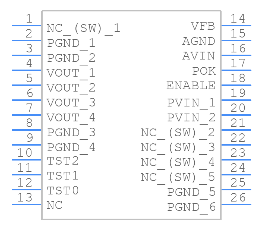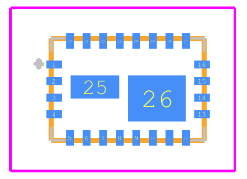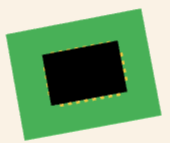EN5339QI DC-DC Converters: Features, Applications and Datasheet
2025-10-27 10:27:03 396
EN5339QI Description
A compact PowerSoC synchronous step-down DC-DC converter, the EN5339QI integrates an inductor, synchronous MOSFETs, PWM controller and compensation in a 4 × 6 × 1.1 mm 24-pin QFN package to deliver up to 3 A of regulated output from a 2.4–5.5 V input in an ultra-small solution footprint.
EN5339QI Features
All-in-one PowerSoC — integrates inductor, drivers and control circuitry for the smallest possible POL (point-of-load) solution.
3 A continuous output capability — supports moderate power rails for SoCs, FPGAs and ASIC core supplies.
Wide input range — operates from 2.4 V to 5.5 V, accommodating common system rails.
Adjustable output (0.6–4.6 V typical) — flexible VOUT selection via resistor divider or VID pins for core and I/O rails.
High switching frequency (≈3.5–4 MHz) — enables use of tiny MLCCs and minimizes total solution area.
High efficiency (up to ~95%) — minimizes thermal dissipation in compact designs.
Thermal-friendly, exposed-pad QFN — bottom thermal pad for PCB heat sinking and reliable thermal performance in small form factors.
Protection features built-in — enable/disable (EN), over-current protection (OCP), over-temperature (OTP), short-circuit protection (SCP) and UVLO for robust system behavior.
EN5339QI Applications
Point-of-load (POL) power for FPGAs/ASICs — supply tight-tolerance core voltages where board area is at a premium.
Embedded processors and SoC rails — compact, high-efficiency conversion for CPUs and NPUs in edge devices.
Telecom and networking modules — powering transceivers and line cards requiring low-ripple, high-efficiency rails.
Storage and server mezzanine cards — on-board buck for memory or core rails in dense server add-in modules.
Compact industrial and medical electronics — small-footprint power for rugged designs with limited PCB area.
EN5339QI CAD Model
Symbol

Footprint

3D Model


EN5339QI Alternatives
EN5322QI / EN5329QI (Enpirion family) — similar integrated PowerSoCs in the same product family at 2 A and 2 A variants respectively for lower current needs.
EN5335QI / EN5337QI (Enpirion family) — other 3 A PowerSoC variants in the Enpirion/EN53xx portfolio if specific pin or feature variants are required.
Discrete/regulator modules from other vendors — compact integrated buck modules or power-stage modules from TI, Murata or RECOM for designers preferring alternate footprints or supply-chain options (compare efficiency, footprint, switching frequency and thermal specs when selecting).
Higher-power Enpirion parts (EN5364QI / EN5394QI) — choose these when your design needs larger continuous currents (6 A–9 A).
EN5339QI Manufacturer
Intel Corporation is a global technology leader headquartered in Santa Clara, California, renowned for designing and manufacturing advanced semiconductors that power computing and connected technologies worldwide. Founded in 1968 by Robert Noyce and Gordon Moore, Intel pioneered the development of the microprocessor, a foundational innovation that transformed modern computing. Today, Intel’s diverse portfolio spans CPUs, GPUs, FPGAs, AI accelerators, networking solutions, and foundry services, serving industries from personal computing to data centers, cloud infrastructure, and autonomous systems. Through its IDM 2.0 strategy, Intel is expanding its global manufacturing capacity and driving innovation in process technology, packaging, and AI-driven computing, reinforcing its mission to shape the future of technology and enable a smarter, more connected world.
EN5339QI FAQs
What input and output voltage ranges does the EN5339QI support?
The device accepts 2.4 V to 5.5 V on VIN and can be configured for outputs typically from 0.6 V up to roughly 4.6 V, making it suitable for many core and I/O rails.
Is an external inductor required on the PCB?
No — the EN5339QI is a PowerSoC with an integrated inductor, so only a small set of external capacitors and a few support components are required, greatly reducing BOM and layout complexity.
How much current can the EN5339QI safely deliver continuously?
It is specified to provide up to 3 A continuous output current in normal operating conditions; thermal design (copper area, vias to PCB ground) will determine safe sustained current on your board.
What switching frequency and benefits does it use?
The EN5339QI operates at a high fixed switching frequency (around 3.5–4 MHz) so designers can use small MLCC output capacitors and achieve a very compact total solution area.
Which protections are integrated and how do they behave?
The module includes enable/disable control, over-current protection (OCP), short-circuit protection (SCP), over-temperature shutdown (OTP) and UVLO — these features protect the load and the converter and simplify system fault handling; consult the datasheet for detailed trip thresholds and fault recovery behavior.




